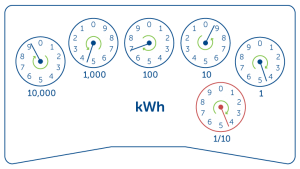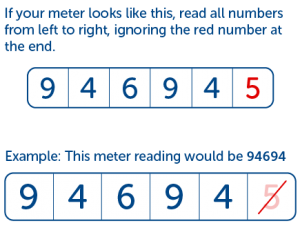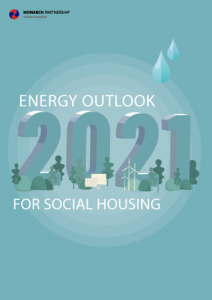Reading your meter
It may seem fairly self-explanatory, but there’s a little bit more to reading your meter – both electric and gas – than simply looking at it and taking a mental note of the numbers. Even if you do find it simple, it’s always worth making sure you are doing it right.
Firstly, there’s not just one type of meter. The first step would be to determine what kind of meter you have. Here’s a list of the different kinds of electric and gas meters:
READING YOUR METER – ELECTRICITY METERS

READING YOUR METER – GAS METERS
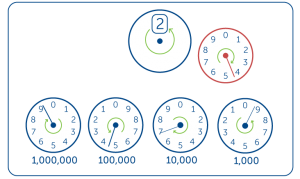
ELECTRICITY METERS
A digital electricity meter shows your current meter reading on a digital display.
- Read your meter display from left to right.
- Ignore any numbers in red and anything that appears after a decimal point or space.
Economy 7/Domestic Economy electricity meters
If you’ve got an Economy 7 or Domestic Economy meter, you’ll have two rows of figures on your digital display:
‘Low’ is the reading for night or off-peak units.
‘Normal’ is the reading for day or peak-time units.
You read your meter the same as a standard digital electricity meter.
Dial electricity meters
Some older electricity meters have dials instead of a row of numbers. They’re simple to read, but it may help you to write down the numbers as you go.
An electric dial meter looks like this:
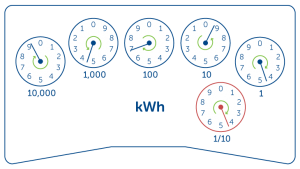
Example: This meter reading would be 94694
How to read an electric dial meter:
- Read the dials from left to right. Ignore the dial marked 1/10.
- If the pointer on a dial is between two numbers, write down the lower number. But if the pointer is between zero and nine, it will always be nine. This is the case for the first and fourth dial on the diagram above.
- If the pointer is exactly on a number but the reading on the dial after it is nine, take one away from that number. On the diagram above the pointer on the third dial is exactly on the seven, but the reading on the fourth dial is a nine, so the reading on the third dial becomes six.
Some electricity tariffs use meters that show two readings when you press a button on the meter. You may have a two-rate meter if you have Economy 7, Economy 10 or Evening and Weekend tariff.
Once you’re at your meter display:
- Press the button on the front of your meter.
- Your meter will show each reading with a label next to it. This could be ‘R1’ and ‘R2’, ‘1’ and ‘2’, ‘L’ and ‘N’ or even ‘low’ and ‘normal’. Which is your day reading and which is your night, depends on how your meter is set up.
If you’re not sure, check the previous readings on your most recent bill. This will show which reading belongs to which rate.
- You may have more than one electricity meter. If so, take your readings as explained above and make a note of the meter serial number on each meter. The meter serial number is usually found on the front of your meter. It may be on a sticker.
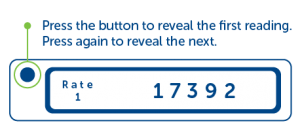
GAS METERS
Your gas meter will be imperial or metric. An imperial meter has four main numbers and a metric meter has five.
How to read your imperial meter
- Read the first four numbers from left to right.
- Include any zeros at the beginning, but don’t include any numbers in red, or anything after a red number.
- If your meter has reached 9,999, it’ll start recording from zero again.

How to read your metric meter
- Read the first five numbers from left to right.
- Include any zeros at the beginning, but don’t include anything after a space or decimal point.
- Once your meter has reached 99,999, it’ll start recording from zero again.
Some older gas meters have dials to read instead of a line of numbers.
A gas dial meter looks something like this:

Example: this meter reading would be 9469
How to read your gas dial meter
- Read all the dials from left to right, but ignore the large dial or any red dials. If the pointer is between two numbers, write down the lower number.
- If the pointer is between zero and nine, use nine. This is the case on the first and fourth dial on the diagram above.
- If the pointer is exactly on a number, write it down and underline it. So on the diagram above, you’d write down and underline the number seven on the third dial.
- If any of the numbers you have written down are followed by a nine, take one away from the underlined number. As the third dial is followed by a nine on the fourth dial, you’d take one away from the seven on the third dial making it six.
We recommend:
Download our Monarch Explains Meter Reading Guide for future reference
View the digital paper version of the Meter Reading Guide
We keep your site and meter data as well as meter readings valid, accurate and always up-to-date with our Smart Asset Management solution.
You can view your refreshed Asset Register online in Customer Zone Reporting anytime, containing your sites, meters, meter readings, locations by utility type, etc.


